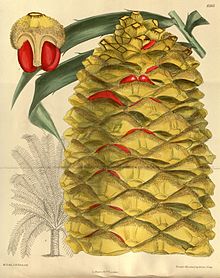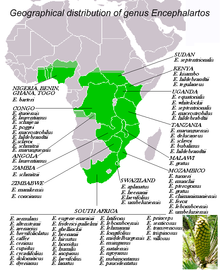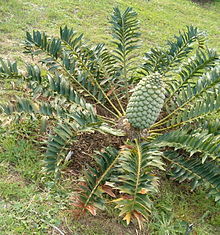Bread palm ferns
| Bread palm ferns | ||||||||||||
|---|---|---|---|---|---|---|---|---|---|---|---|---|

|
||||||||||||
| Systematics | ||||||||||||
|
||||||||||||
| Scientific name | ||||||||||||
| Encephalartus | ||||||||||||
| Clay. |
The encephalartos ( Encephalartos ) are a genus of flowering plants in the family of Zamiaceae within the order of cycads (Cycadales). The genus Encephalartos is restricted from distribution to Africa . All around 65 species of Encephalartos are threatened and are listed in Appendix I of the Washington Convention on Endangered Species (CITES).
description


The stem axis is formed underground or as an above-ground trunk. Underground it reaches a diameter of 15 centimeters. Tree-shaped trunks reach heights of up to 15 meters. The stems are cylindrical and pachycaul . Many species form additional shoots at the base of the trunk so that old plants can form a large clump. Otherwise branching is extremely rare.
The leaves are in a spiral arrangement at the end of the trunk. The cataphylls formed between the leaves are simply pinnate and very variable. The length ranges from 60 to 600 centimeters, the surface is dull to shiny, the color ranges from blue-gray to yellow-green to dark green. The rachis is curved inwards, straight or curved outwards to strongly bent back. The leaflets are often almost vertical from the rachis. They are narrow to wide, unreinforced or thorny. The lower leaflets are often completely transformed into thorns.
The female cones stand individually or up to eight on a plant. The size ranges from 30 cm long and 15 cm wide to 80 cm long and 40 cm wide. They are seated or stalked, erect or nodding. The color ranges from blue-gray to light and dark green to brown, chestnut brown, yellow, orange, pink and red. The surface of the cone can be smooth, pimply or wrinkled, bald to thickly hairy. The sporophylls are simple, fleshy, and have two (rarely three) orthotropic ovules on the adaxial side , the micropyle of which points towards the cone axis.
The male cones are more numerous than the female. The stems are usually longer than the female ones, otherwise the cones resemble the female ones. On each sporophyll there are numerous pollen sacs on the underside (abaxial). These open with slits. The pollen is boat-shaped (cymbiform) and has a germ fold (monosulcat).
The seeds are elongated to ellipsoidal, the sarcotesta is fleshy and red, yellow, orange or brown in color. The endosperm is habloid and is formed by the female gametophyte . The embryo has two cotyledons, which are usually connected at the tip, and a long, spiral suspensor . The germination extends kryptokotylar.
The number of chromosomes is 2n = 18.
Distribution and locations
The genus bread palm ferns ( Encephalartos ) is restricted to Africa. The northern limit of their occurrence runs from Sudan via the Central African Republic, Nigeria to Ghana. In the south it occurs to South Africa. The focus is on eastern and southern Africa, with only Encephalartos barteri on the west coast .
The locations are extremely diverse, bread palm ferns grow in deserts, savannas and forests, but they are absent in rainforests. They occur at altitudes from sea level up to 2400 meters.
Systematics
The genus Encephalartos alone forms the Subtribus Encephalartinae , and together with the Subtribus Microzamiinae the tribe Encephalarteae . Up to 2002, about 63 species were distinguished within the genus; in the meantime other species ( Encephalartos flavistrobilus , Encephalartos mackenziei ) were added.
The types described so far are:
- Encephalartos aemulans Vorster : It occurs in KwaZulu-Natal.
- Encephalartos altensteinii clay. : It occurs in South Africa.
- Encephalartos aplanatus Vorster : The home is Swaziland.
- Encephalartos arenarius R.A. Dyer : It occurs in South Africa.
-
Encephalartos barteri Carruth. ex Miq. : It occurs in two subspecies in tropical West Africa:
- Encephalartos barteri subsp. allochrous L.E. Newton : It occurs in Nigeria.
- Encephalartos barteri subsp. barteri : It occurs in tropical West Africa.
- Encephalartos brevifoliolatus Vorster : It occurred in the Limpopo province.
- Encephalartos bubalinus Melville : It occurs in Kenya and Tanzania.
- Kafir bread palm fern ( Encephalartos caffer (Thunb.) Lehm. ): It occurs in South Africa.
- Encephalartos cerinus Lavranos & DLGoode : The home is KwaZulu-Natal.
- Encephalartos chimanimaniensis R.A.Dyer & I.Verd. : It occurs in western Mozambique and also occurred in eastern Zimbabwe.
- Encephalartos concinnus R.A.Dyer & I.Verd. : The home is Zimbabwe.
- Encephalartos cupidus R.A.Dyer : The home is the South African province of Mpumalanga .
- Encephalartos cycadifolius clay. : She comes in South Africa.
- Encephalartos delucanus Malaisse, JPSclavo & C.Crosiers : The home is Tanzania.
- Encephalartos dolomiticus Lavranos & DLGoode : The homeland is the province of Limpopo .
- Encephalartos dyerianus Lavranos & DLGoode : The homeland is the province of Limpopo .
- Encephalartos equatorialis P.JHHurter : The home is south-eastern Uganda.
- Encephalartos eugene-maraisii I. Verd. : The homeland is the province of Limpopo .
-
Encephalartos ferox G.Bertol. : It occurs from Mozambique to KwaZulu-Natal. There are two subspecies:
- Encephalartos ferox subsp. emersus P.Rousseau, Vorster & AEvan Wyk : It was first described in 2015 from Mozambique.
- Encephalartos ferox subsp. ferox : It occurs from Mozambique to KwaZulu-Natal.
- Encephalartos flavistrobilus I.S. Turner & Sclavo : It was first described in 2006 from Zimbabwe.
- Encephalartos friderici-guilielmi clay. : It occurs in South Africa and in KwaZulu-Natal.
- Encephalartos ghellinckii Lem. : It occurs in South Africa and in KwaZulu-Natal.
- Encephalartos gratus Prain : It occurs in Malawi and Mozambique.
- Encephalartos heenanii R.A.Dyer : It occurs in northwestern Swaziland and southeastern Mpumalanga .
- Encephalartos hildebrandtii A.Braun & CDBouché : It occurs from southeastern Kenya to northeastern Tanzania.
- Encephalartos hirsutus P.JHHurter : The homeland is the province of Limpopo .
- Encephalartos horridus (Jacq.) Clay. : It occurs in South Africa.
- Encephalartos humilis I. Verd. : The home is the South African province of Mpumalanga .
- Encephalartos inopinus R.A.Dyer : The home is the province of Limpopo .
- Encephalartos ituriensis Bamps & Lisowski : It occurs in Zaire and Uganda.
- Encephalartos kisambo Faden & Beentje : It occurs in southeastern Kenya and in northeastern Tanzania.
- Encephalartos laevifolius Stapf & Burtt Davy : It occurs in South Africa.
- Encephalartos lanatus Stapf & Burtt Davy : The home is the South African province of Mpumalanga .
- Encephalartos latifrons clay. : It occurs in South Africa.
- Encephalartos laurentianus De Wild. : It occurs in Angola and Zaire.
- Lebombo bread palm fern ( Encephalartos lebomboensis I.Verd. ): It occurs from Mozambique to KwaZulu-Natal.
- Karoo bread palm fern ( Encephalartos lehmannii Lehm. ): It occurs in South Africa.
- Suurberg bread palm fern ( Encephalartos longifolius (Jacq.) Lehm. ): It occurs in South Africa.
- Encephalartos mackenziei L.E. Newton : It wasfirst describedin 2002 from eastern South Sudan .
- Encephalartos macrostrobilus Scott Jones & J.Wynants : The home is northern Uganda.
- Encephalartos manikensis (Gilliland) Gilliland : The home is Zimbabwe and Mozambique.
- Encephalartos marunguensis Devred : The home is Zaire.
- Encephalartos middelburgensis Vorster, Robbertse & S.van der Westh. : The home is the South African province of Mpumalanga .
- Encephalartos msinganus Vorster : The home is KwaZulu-Natal.
- Encephalartos munchii R.A.Dyer & I.Verd. : The home is Mozambique.
- Encephalartos natalensis R.A.Dyer & I.Verd. : The home is KwaZulu-Natal.
- Encephalartos ngoyanus I. Verd . : The home is KwaZulu-Natal and Swaziland.
- Encephalartos nubimontanus P.JHHurter : The last observation of the species is from 2001. It occurred in the Limpopo province.
- Encephalartos paucidentatus Stapf & Burtt Davy : It occurs in Mpumalanga and Swaziland.
- Encephalartos poggei ash. : It occurs in Zaire and northeastern Angola.
- Encephalartos princeps R.A.Dyer : It occurs in South Africa.
- Encephalartos pterogonus R.A.Dyer & I.Verd. : The home is Mozambique.
- Encephalartos relictus P.JHHurter : This species was first described in 2001 from eastern Swaziland, but has become extinct.
- Encephalartos schaijesii Malaisse, JPSclavo & C.Crosiers : The home is Zaire.
- Encephalartos schmitzii Malaisse : The home is Zaire and Zambia.
- Encephalartos sclavoi De Luca, DWStev. & A.Moretti : The homeland is northeastern Tanzania.
- Encephalartos senticosus Vorster : It occurs in Swaziland and KwaZulu-Natal.
- Encephalartos septentrionalis Schweinf. ex Eichl. : It occurs from northern Uganda and southern Sudan to Zaire and the Central African Republic.
-
Encephalartos tegulaneus Melville : The two subspecies both occur only in Kenya:
- Encephalartos tegulaneus subsp. powysii Miringu & Beentje
- Encephalartos tegulaneus subsp. tegulaneus
- Modiaji bread palm fern ( Encephalartos transvenosus Stapf & Burtt Davy ): The homeland is the province of Limpopo .
- Encephalartos trispinosus (Hook.f.) RADyer : It occurs in South Africa.
- Encephalartos turneri Lavranos & D.Goode : The home is Mozambique.
- Encephalartos umbeluziensis R.A.Dyer : The home is Mozambique and Swaziland.
- Encephalartos villosus Lem. : It occurs from the Eastern Cape to Swaziland.
- Encephalartos whitelockii P.JHHurter : The home is southwest Uganda.
- Encephalartos woodii Sander : This species from KwaZulu-Natal is extinct in the wild. Several clones of the last known specimen exist in botanical gardens.
Botanical history
The genus Encephalartos was first described by the German botanist Johann Georg Christian Lehmann in 1834 . Before that, all cycads were grouped into the genus Zamia . The generic name Encephalartos means something like bread in the head and alludes to the use of the stem pulp as a starch supplier. Lehmann had also classified the Australian species of the family in the genus Encephalartos , which have now been transferred to their own genera Macrozamia and Lepidozamia .
use
Different types of Encephalartos were used to provide starch . Both the seeds and the pulp were processed into flour, mainly in times of need. The toxins were removed by repeated washing.
Several species of Encephalartos are used primarily in their natural range as ornamental plants in parks and gardens, especially in South Africa.
literature
- Loran M. Whitelock: The Cycads. Timber Press, Portland OR 2002, ISBN 0-88192-522-5 , pp. 174 f. (Characteristics, distribution, use).
- KD Hill: Genus Encephalartos on Cycad Pages of the Royal Botanic Gardens Sydney , accessed April 22, 2008. (Characteristics)
Individual evidence
- ↑ Loran M. Whitelock: The Cycads. 2002. pp. 175-241.
- ↑ a b c d e f g h i j k l m n o p q r s t u v w x y z aa ab ac ad ae af ag ah ai aj ak al am an ao ap aq ar as at au av aw ax ay az ba bb bc bd be bf bg bh bi bj bk bl bm bn bo bp bq br bs Rafaël Govaerts (Ed.): Encephalartos. In: World Checklist of Selected Plant Families (WCSP) - The Board of Trustees of the Royal Botanic Gardens, Kew . Retrieved March 14, 2019.
- ↑ a b c d e Walter Erhardt among others: The great pikeperch. Encyclopedia of Plant Names . Volume 2, page 1387. Verlag Eugen Ulmer, Stuttgart 2008. ISBN 978-3-8001-5406-7
- ^ South African National Biodiversity Institute : Encephalartos woodii Sander . May 2002. Retrieved April 27, 2020.
- ↑ Novarum et Minus Cognitarum Stirpium Pugillus. Volume 6, 1834, p. 3. ( online )
- ↑ Entry on Encephalartos woodii at plantzafrica.com . (English)
Web links
- Information at wild-about-you.com (English)
- Geoff Stein: The Encephalartos Species: THE collector genus of cycad , article at davesgarden.com (English)







